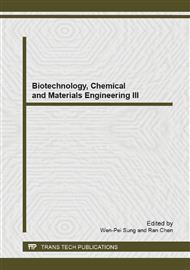[1]
Zhang Z., Wang H., Zhu J., Suneethi S. and Zheng J: Swine manure vermicomposting via housefly larvae (Musca domestica): the dynamics of biochemical and microbial features. Bioresour Technol. 118 (2012), pp.563-571.
DOI: 10.1016/j.biortech.2012.05.048
Google Scholar
[2]
Peck G.W. and Kirkup B.C.: Biocompatibility of antimicrobials to maggot debridement therapy: medical maggots Lucilia sericata (Diptera: Calliphoridae) exhibit tolerance to clinical maximum doses of antimicrobials. J Med Entomol. 49 (2012).
DOI: 10.1603/me12066
Google Scholar
[3]
Chu F.J., Jin X.B. and Zhu J.Y., Housefly (Musca domestica) maggot protein-enriched fraction/extracts (PE) inhibit lipopolysaccharide-induced atherosclerosis pro-inflammatory responses. J Atheroscler Thromb. 18(2011), pp.282-290.
DOI: 10.5551/jat.5991
Google Scholar
[4]
Chu F.J., Jin X.B., Xu Y.Y., Ma Y., Li X.B., Lu X.M., Liu W.B. and Zhu JY: Inflammatory Regulation Effect and Action Mechanism of Anti-Inflammatory Effective Parts of Housefly (Musca domestica) Larvae on Atherosclerosis. Evid Based Complement Alternat Med, 2013(2013).
DOI: 10.1155/2013/340267
Google Scholar
[5]
Desai A., Darland G., Bland J.S., Tripp M.L. and Konda V.R.: META060 attenuates TNF-α-activated inflammation, endothelial-monocyte interactions, and matrix metalloproteinase-9 expression, and inhibits NF-κB and AP-1 in THP-1 monocytes. Atherosclerosis. 223(2012).
DOI: 10.1016/j.atherosclerosis.2012.05.004
Google Scholar
[6]
Zhu Y.P., Shen T., Lin Y.J., Chen B.D., Ruan Y., Cao Y., Qiao Y., Man Y., Wang S. and Li J: Astragalus polysaccharides suppress ICAM-1 and VCAM-1 expression in TNF-α-treated human vascular endothelial cells by blocking NF-κB activation. Acta Pharmacol Sin. 34(2013).
DOI: 10.1038/aps.2013.46
Google Scholar
[7]
Chen X.Z., Cao Z.Y., Chen T.S., Zhang Y.Q., Liu Z.Z., Su Y.T., Liao L.M. and Du J, Water extract of Hedyotis Diffusa Willd suppresses proliferation of human HepG2 cells and potentiates the anticancer efficacy of low-dose 5-fluorouracil by inhibiting the CDK2-E2F1 pathway. Oncol Rep. 28(2012).
DOI: 10.3892/or.2012.1834
Google Scholar
[8]
Satchi-Fainaro R., Ferber S., Segal E., Ma L., Dixit N., Ijaz A., Hlatky L., Abdollahi A. and Almog N: Prospective identification of glioblastoma cells generating dormant tumors. PLoS One. 7 (2012), e44395.
DOI: 10.1371/journal.pone.0044395
Google Scholar
[9]
Chu F.J., Jin X.B., Xu Y.Y., Ma Y., Li X.B., Lu X.M., Liu W.B. and Zhu JY: Effect of lipopolysaccharide mediating early- and late- activated THP-1 macrophages on ECV304 endothelial cell dysfunction: dysregulation of secretion of VEGF and proliferation and migration of ECV304. Cell Physiol Biochem. 31(2013).
DOI: 10.1159/000343377
Google Scholar
[10]
Sprague A.H. and Khalil R.A.: Inflammatory cytokines in vascular dysfunction and vascular disease. Biochem Pharmacol. 78(2009), pp.539-552.
DOI: 10.1016/j.bcp.2009.04.029
Google Scholar
[11]
Zhuang G., Wu X., Jiang Z., Yao J., Guan Y., Oeh J., Modrusan Z., Bais C., Sampath D. and Ferrara N.: Tumour-secreted miR-9 promotes endothelial cell migration and angiogenesis by activating the JAK-STAT pathway. EMBO J. 31(2012), pp.3513-3523.
DOI: 10.1038/emboj.2012.183
Google Scholar
[12]
Zhang H., Park Y., Wu J., Chen X.P., Lee S., Yang J., Dellsperger K.C. and Zhang C: Role of TNF-alpha in vascular dysfunction. Clin Sci (Lond). 116(2009), pp.219-230.
DOI: 10.1042/cs20080196
Google Scholar
[13]
Wang Y., Zang Q.S., Liu Z., Wu Q., Maass D., Dulan G., Shaul P.W., Melito L., Frantz D.E., Kilgore J.A., Williams N.S., Terada L.S. and Nwariaku F.E.: Regulation of VEGF-induced endothelial cell migration by mitochondrial reactive oxygen species. Am J Physiol Cell Physiol. 301(2011).
DOI: 10.1152/ajpcell.00322.2010
Google Scholar


